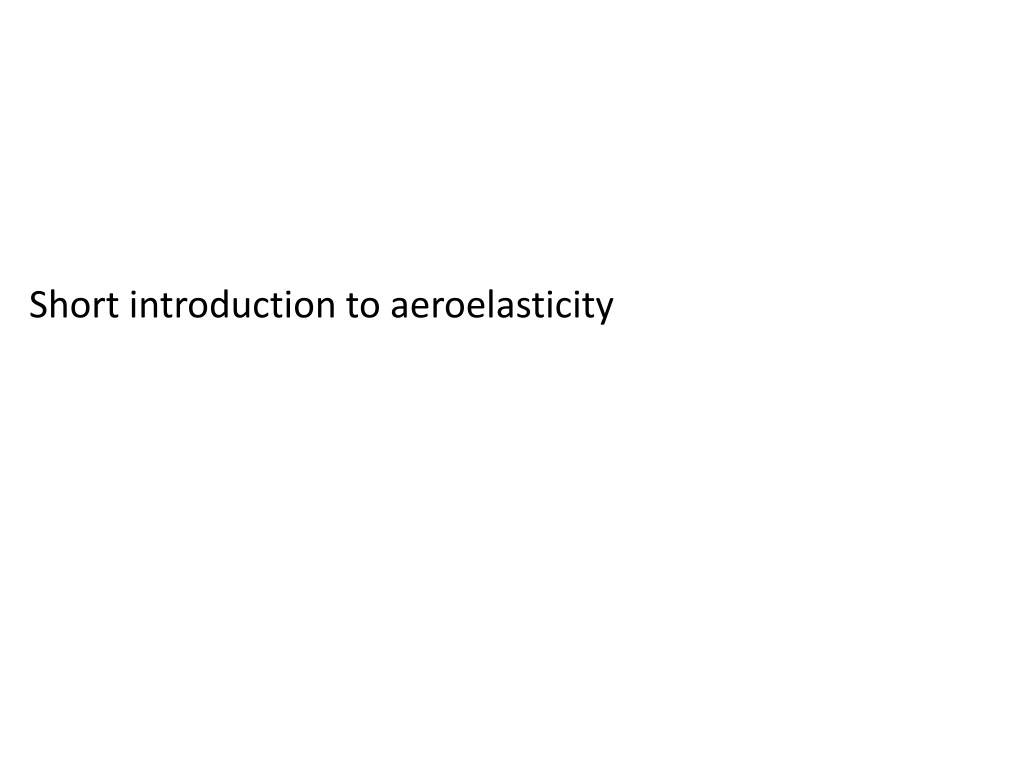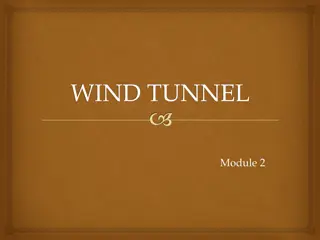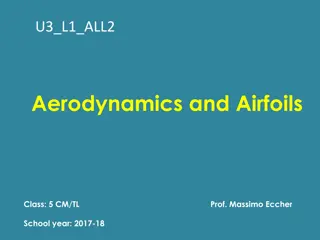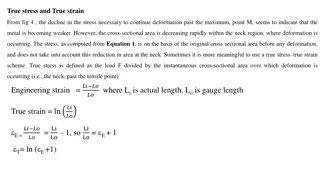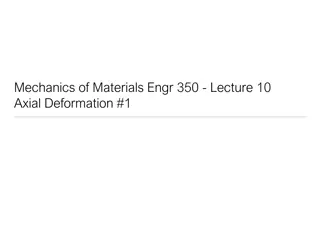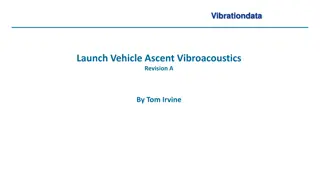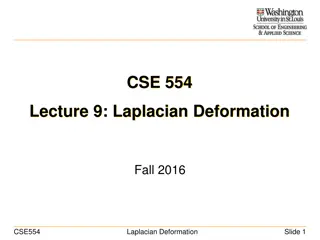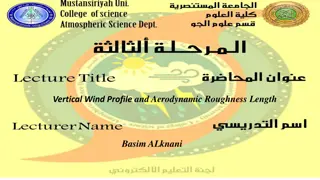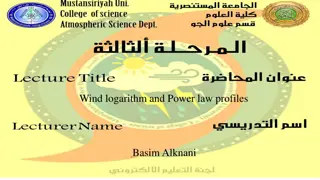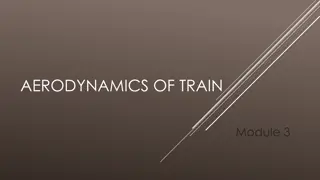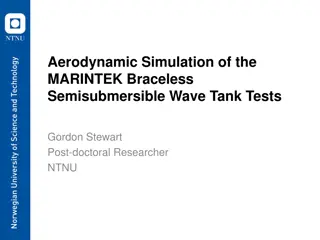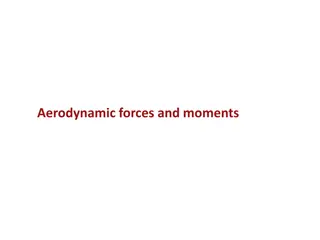Understanding Aeroelasticity: Deformation and Aerodynamic Forces
Aeroelasticity explores the intricate relationship between the deformation of elastic structures in an airstream and the resulting aerodynamic forces. This field of study is vital for predicting and managing interactions between structural mechanics and aerodynamics in aircraft design. Historical incidents such as flutter in aircraft highlight the importance of aeroelastic considerations in aviation advancements.
Download Presentation

Please find below an Image/Link to download the presentation.
The content on the website is provided AS IS for your information and personal use only. It may not be sold, licensed, or shared on other websites without obtaining consent from the author. Download presentation by click this link. If you encounter any issues during the download, it is possible that the publisher has removed the file from their server.
E N D
Presentation Transcript
Introduction Aeroelasticity is the term used to denote the field of study concerned with the interaction between the deformation of an elastic structure in an airstream and the resulting aerodynamic force. http://gtt.epfl.ch/files/content/sites/gtt/files/Images/Virginie/Collar%20triangle_500.jpg Classical prediction of the forces acting on a body of a given shape. Elasticity provides a prediction of the shape of an elastic body under a given load. aerodynamic theories provide a
Introduction In aeroelasticity, one finds that the loads depend on the deformation (i.e., aerodynamics) and that the deformation depends on the loads (i.e., structural mechanics/dynamics); thus, one has a coupled problem. It is of interest that aeroelastic phenomena played a major role throughout the history of powered flight. The Wright brothers utilized controlled warping of the wings on their Wright Flyer in 1903 to achieve lateral control. This was essential to their success in achieving powered flight because the aircraft was laterally unstable due to the significant anhedral of the wings.
Introduction The first recorded and documented case of flutter in an aircraft occurred in 1916. The Handley Page O/400 bomber experienced violent tail oscillations as the result of the lack of a torsion-rod connection between the port and starboard elevators an absolute design requirement of today. The incident involved a dynamic twisting of the fuselage to as much as 45 degrees in conjunction with an antisymmetric flapping of the elevators. Catastrophic failures due to aircraft flutter became a major design concern during the First World War and remain so today. R. A. Frazer and W. J. Duncan at theNational Physical Laboratory in England compiled a classic document on this subject entitled, The Flutter of Aeroplane Wings
Introduction Another major aircraft-design concern that may be classified as a static aeroelastic phenomenon was experienced in 1927 by the Bristol Bagshot, a twin engine, high-aspect-ratio English aircraft. As the speed was increased, the aileron effectiveness decreased to zero and then became negative. This loss and reversal of aileron control is commonly known today as aileron reversal. Aileron reversal generally does not lead to a catastrophic failure, it can be dangerous and therefore is an essential design concern
Introduction Steady (static) aeroelasticity: The field of static aeroelasticity is the study of flight- vehicle phenomena associated with the interaction of aerodynamic loading induced by steady flow and the resulting elastic deformation of the lifting-surface structure. These phenomena are characterized as being insensitive to the rates and accelerations of the structural deflections. There are two types Divergence and control reversal.
Introduction Steady (static) aeroelasticity: no inertial terms influence http://www.dailymotion.com/video/x10uqvs_wing-bending- a350_tech?search_algo=2 Divergence occurs when the moments due to aerodynamic forces overcome the restoring moments due to structural stiffness, so resulting in aircraft failure Control surface reversal the effect that aeroelastic deflections of the flexible wing have on the aerodynamic influence, or effectiveness, of the control surface in comparison to rigid wing. When the speed increases the effectiveness reduces until at some critical speed, called the reversal speed, this no response to application of the control surface.
Introduction Dynamic aeroelasticity The instability called flutter, which generally leads to a catastrophic structural failure of a flight vehicle. A formal definition of aeroelastic flutter is as follows: a dynamic instability of a flight vehicle associated with the interaction of aerodynamic, elastic, and inertial forces. From this definition, it is apparent that any investigation of flutter stability requires an adequate knowledge of the system s structural dynamic and aerodynamic properties. Flutter is a self-excited and potentially destructive oscillatory instability in which aerodynamic forces on a flexible body couple with its natural modes of vibration to produce oscillatory motions with increasing amplitude.
Introduction Dynamic aeroelasticity The level of vibration will increase, resulting in oscillatory motion with amplitude sufficiently large to cause structural failure. Of the various phenomena that are categorized as aeroelastic flutter, lifting surface flutter is most often encountered and most likely to result in a catastrophic structural failure. As a result, it is required that lifting surfaces of all flight vehicles be analyzed and tested to ensure that this dynamic instability will not occur for any condition within the vehicle s flight envelope.
Introduction Dynamic aeroelasticity The objective of such an analysis is to determine the flight conditions that correspond to the flutter boundary. It was previously noted that the flutter boundary corresponds to conditions for which one of the modes of motion has a simple harmonic time dependency. Because this is considered to be a stability boundary, it is implied that all modes of motion are convergent (i.e., stable) for less critical flight conditions (i.e., lower airspeed). Moreover, all modes other than the critical one are convergent at the flutter boundary.
Introduction Dynamic aeroelasticity The objective of such an analysis is to determine the flight conditions that correspond to the flutter boundary. It was previously noted that the flutter boundary corresponds to conditions for which one of the modes of motion has a simple harmonic time dependency. Because this is considered to be a stability boundary, it is implied that all modes of motion are convergent (i.e., stable) for less critical flight conditions (i.e., lower airspeed). Moreover, all modes other than the critical one are convergent at the flutter boundary. It is presumed that the solution involves simple harmonic motion. With such a solution specified, the equations of motion are then solved for the flight condition(s) that yields such a solution.
Introduction Dynamic aeroelasticity The objective of such an analysis is to determine the flight conditions that correspond to the flutter boundary. It was previously noted that the flutter boundary corresponds to conditions for which one of the modes of motion has a simple harmonic time dependency. Because this is considered to be a stability boundary, it is implied that all modes of motion are convergent (i.e., stable) for less critical flight conditions (i.e., lower airspeed). Moreover, all modes other than the critical one are convergent at the flutter boundary. It is presumed that the solution involves simple harmonic motion. With such a solution specified, the equations of motion are then solved for the flight condition(s) that yields such a solution.
Introduction Dynamic aeroelasticity The instability called flutter, which generally leads to a catastrophic structural failure of a flight vehicle. A formal definition of aeroelastic flutter is as follows: a dynamic instability of a flight vehicle associated with the interaction of aerodynamic, elastic, and inertial forces. Flutter http://www.youtube.com/watch?v=OhwLojNerMU http://www.youtube.com/watch?v=aZQlmxrmjXQ Dynamic response (gust) Buffeting Transonic buffetting
Introduction Very large, fully coupled CFD/CSD aeroelastic models: Random Averaged Navier Stokes, Large Eddy Structures, nonlinear Finite Elements. Aeroelastic tailoring: include aeroelastic calculations in the preliminary design process. Optimize aircraft while observing aeroelastic constraints. Active aeroelastic structures: flexible aircraft structures that can be deformed actively or passively to optimize aerodynamic characteristics.
